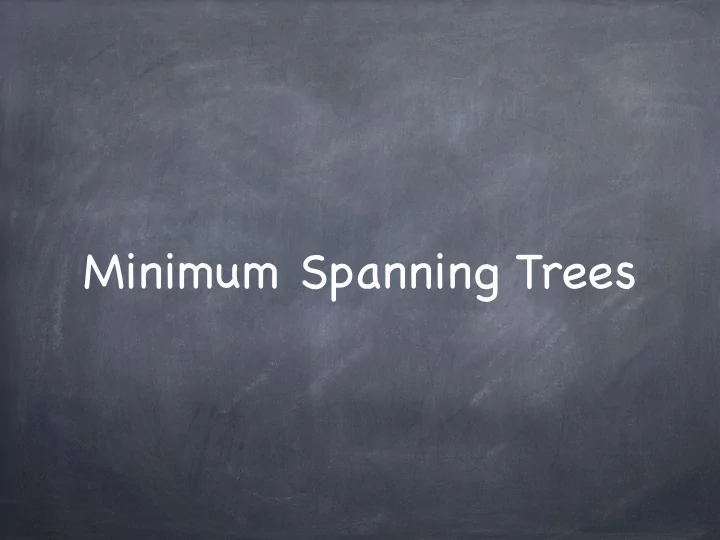

Minimum Spanning Trees
A Network Design Problem Given: undirected graph G = (V , E) with edge costs c e > 0 5" b" c" 2" 1" 8" a" d" 7" 3" Find: edge subset T ⊆ E such 4" 6" that (V , T) is connected and e" f" 9" total cost ∑ e ∈ T c e is as small as possible Fundamental problem with many applications!
Example Example on board: total cost of different subgraphs
Minimum Spanning Tree Problem Lemma. Let T be a minimum-cost solution of the network design problem. Then (V , T) is a tree. Proof on board Definition. T ⊆ E is a spanning tree if (V , T) is a tree Network design problem is the Minimum Spanning Tree (MST) Problem
Greedy MST Template (Kruskal and Prim) “Grow” a tree greedily T = {} While |T| < n-1 { / / (V , T) is not connected Pick “best” edge e that does not create a cycle when added to T T = T ∪ {e} }
Kruskal’ s Algorithm Grow many small trees Sort edges by weight: c 1 ≤ c 2 ≤ … ≤ c m T = {} for e = 1 to m { if adding e to T does not cause a cycle { T = T ∪ {e} } } Example on board
Prim’ s Algorithm Grow a tree outward from starting node s T = {} S = {s} / / connected nodes While |T| < n-1 { Let e = (u, v) be the minimum cost edge from S to V-S T = T ∪ {e} S = S ∪ {v} } Example on board
Analysis: Cut Property Simplifying assumption. All edge weights are distinct. Theorem (Cut Property). Assume edge weights are distinct, and let (S, V-S) be a partition of V into two nonempty sets. Let e = (v, w) be the minimum cost with v ∈ S and w ∉ S. Then every minimum spanning tree contains e. Illustration and proof on board
Correctness of Prim’ s Algorithm Theorem: the tree T returned by Prim’ s algorithm is a minimum spanning tree. Proof? (Hint: maintain invariant that T is a subset of some MST, use the cut property)
Correctness of Kruskal’ s Algorithm Theorem: the tree T returned by Kruskal’ s algorithm is a minimum spanning tree. Proof? What cut can you use to prove that Kruskal’ s algorithm is correct?
Removing Distinctness Assumption Idea: Break ties in weights by adding tiny amount to each edge weight so they become distinct. If perturbations are small enough then: cost(T) > cost(T’) before ⇒ cost(T) > cost(T’) after Implementation: break ties arbitrarily (e.g., lexicographically)
Network Design: Steiner Tree Problem Given: undirected graph G = (V , E) with edge costs c e > 0 5" and terminals X ⊆ V b" c" 2" 1" 8" Find: edge subset T ⊆ E such a" d" 7" 3" that (V , T) has a path between 4" 6" e" f" each pair of terminals and the 9" total cost ∑ e ∈ T c e is as small as possible Easier? Harder?
Spatial Conservation Planning " !"#$%# • Which land should I buy to maximize the spread ... of an endangered species? • Optimization problem over a graph: decide which nodes to add to the graph, given a fixed budget
Conservation Strategies Initial population Conservation Reservoir Building outward from sources Corridors Our solution Greedy baseline Formulate and solve network design problem as an integer program
Recommend
More recommend